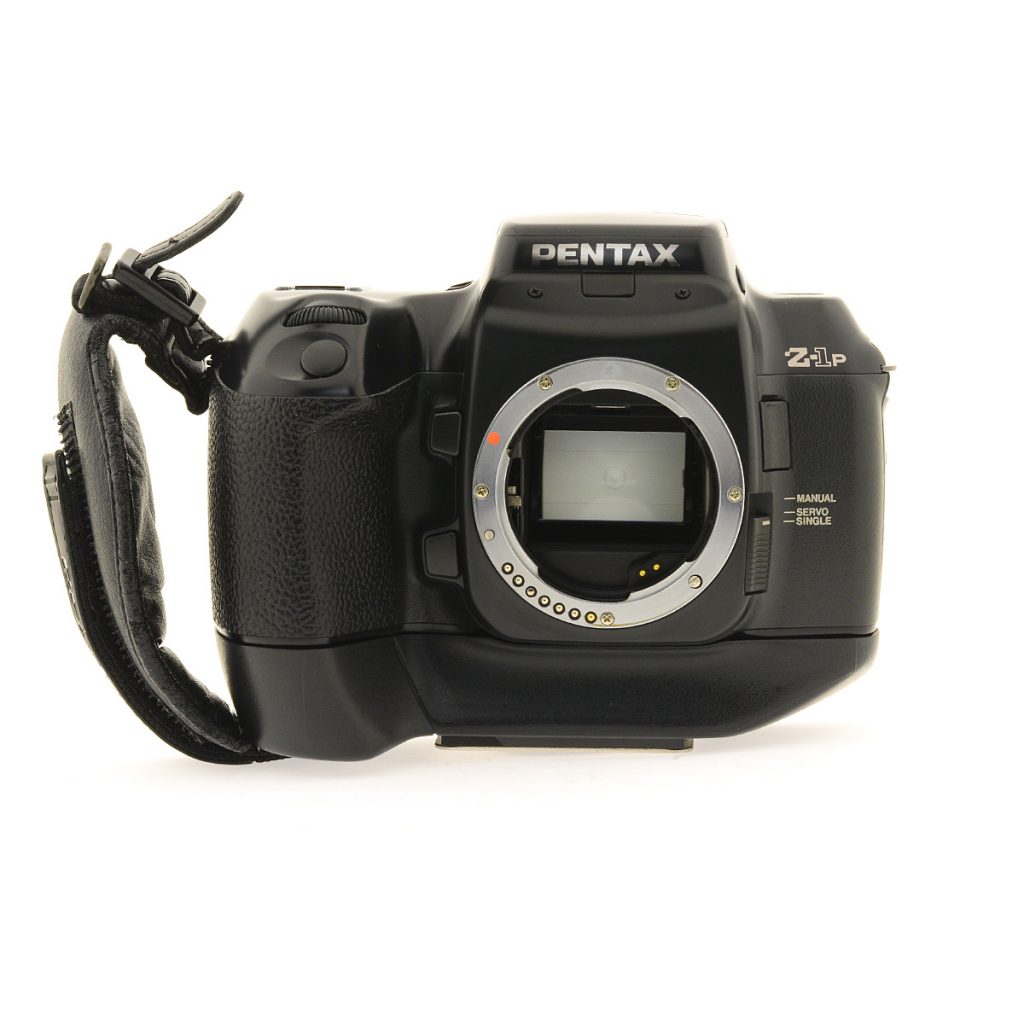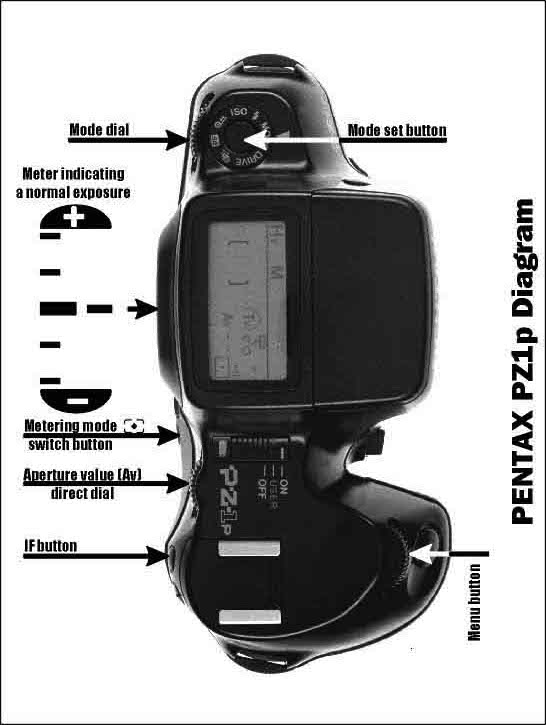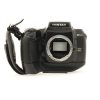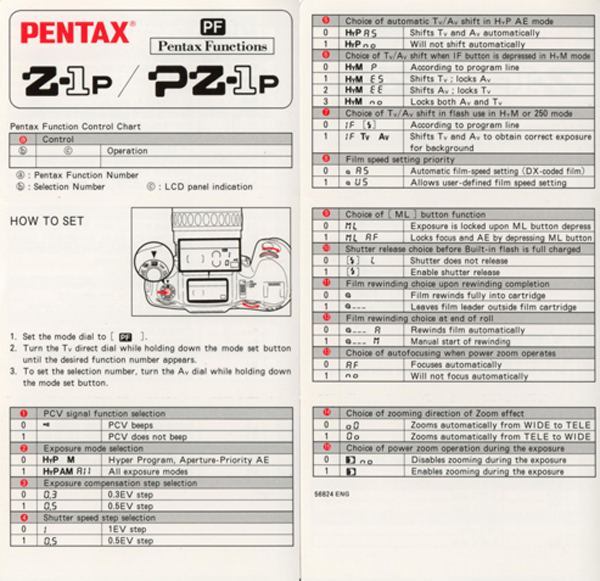[nk_awb awb_type=”color” awb_color=”rgba(255,255,255,0.98)”]
Pentax PZ-1p Camera |
||||||||||||||||||||||||||||||||||||||||||||||||||||||||||||
|
Overview Overview This camera is discontinued, but probably still can be found in some shops or as a second hand. The Pentax PZ-1p is a good alternative for those wishing a high featured camera without spending a lot of money. One of Pentax’s high-end autofocus 35mm SLR, the PZ-1p has all of the required features demanded by professional photographers. It is capable of a shutter speed of 1/8000 sec with 1/250 sec flash sync. The motor allows up to 4 frames per second for continuous shooting. Now this camera is replaced by new Pentax MZ-S. Features
OperationAs with others in its class, the camera comes with standard aperture and shutter priority. The PZ-1p uses a basic, but adequate eight segment multi-pattern metering system which handled most of our shooting situations with flying colors, comparable in performance to autofocus 35mm SLRs priced at over $1500. The metering system is perfect and never fails, even under difficult lightning conditions. Key functions are programmable and the camera can be taught to know your shooting habits in different situations. Customizing the camera functions was the easiest of any autofocus 35mm SLR. The powerful built-in flash can also be set to fire at varying strengths to get the correct exposure. Doing so, in fact, led to three images with quite different feels, all of which were “usable”. For serious photographers, we recommend a dedicated flash unit, such as the Pentax AF500FTZ. For basic sports photography, the predictive autofocus was as good as any found on $1500 cameras. Predictive autofocus kicks in automatically in AF Servo mode when it detects the subject moving. The PZ-1p has its dials placed in comfortable positions, and reachable by different sized hands. The body has a “futuristic” look to it, with buttons and dials located discreetly, but within easy reach. Pentax does not have the range of lenses of some other companies, but Pentax’s lenses are top notch and comes in focal lengths for every picture taking situation. I have been using SLR’s from different manufactors for around 10 years and know the technical side of photography inside-out, but I had to spend an hour with the manual to get the hang of this camera. The whole point is that when making pictures you just keep looking through the viewfinder and adjust f-stop and shutter speed with two dials, while the finder shows you the information you need. You very seldom have to remove the eye from the finder for the purpose of adjusting something when shooting. This SLR has an unusual user interface The Z-1p has something called “hyper-manual” and “hyper program”. In both modes you adjust shutter speed with one dial and f-stops with another. The finder shows the selected values in “hyper manual” also an over/under exposure scale in 1/3 stops. A small button picks a shutter/f-stop combination that satisfies the meter reading, this is really nice when something unexpected happens.

´ In hyper program you adjust the same way but when you adjust f-stop the camera adjusts shutter speed just like traditional aperture priority, when you adjust shutter speed the camera adjusts f-stop like in shutter priority, when the light changes the camera adjusts one or both values to adapt just like a traditional program mode. These two modes are the only ones beside “B” that I have been using. There’s traditional aperture priority, shutter priority and program modes, but the two hyper modes are so much more convenient. No more need to switch between aperture, shutter priority, manual and program mode in the middle of shooting. When shooting landscapes and the like with the camera mounted on a tripod you suddenly figures out why Pentax choose to put a large lcd on top of the prism house. It holds information such as f-stop, shutter speed, amount of over/under exposure with the current setting shown in 1/3 f-stops, metering mode, indicators for bracketing, exposure compensating, mirror lock-up, spot/center/matrix and a handful of other indicators however it’s big enough to be useful from up to a meter away. Pros and ConsPros This camera comes with shutter speeds from 30s-1/8000s, synchs up to 1/250s, can do fill flash magic automatically, and has auto bracketing settable in 1/3 or 1/2 steps. Bracketing also works with flash and fill flash. Camera has unusual Hyper Modes with dual dial knobs – one for aperture, second for shutter time. There’s mirror lockup, when the camera flips up the mirror, stops down the lens and then wait 2 seconds before making the exposure. The focusing screen can be changed by the user. There’s a built in flash with a guidenumber of 14 that spreads enough for a 28 mm lens. An on camera flash isn’t of course the most usefull thing around, but it can save the day when caught without a real flash, and it can of course be used to sync off camera flashes with slaves. The Pentax 500 FTZ flash has a built in slave, so this is a very usefull feature. What would improve this camera I miss being able to set longer exposures than 30 s. without resorting to B-mode and cable remote. It would be trivial from a programmer/ee point of view to let the uset dial in arbitrarily long exposure times by turning one of the dials and seing the exposure time shown in the finder or the display. But I think more like 30s long exposure time is very rare, I think it can be found only in medium format cameras. Pentax would not hear any complaints from me if they forgot about the patetic panorama function. It’s just two pieces of metal that blocks light to the top and bottom of the film during exposure. An optional method for keeping the battery in a shirt pocket when shooting in cold weather would be nice. It was available on the earlier top of the line models, but has been dropped for the Z-1p? models. An option that let’s one use standard AA batteries instead of the photo specific 2CR5 lithium battery, could save the day in less industrialized countries when the bag with the spare batteries get’s stolen and you have to resupply locally. An updated AF with more focus spots etc. would be nice. But, as I must say, the system with selectable points of focus is not very usable – like those in Nikon F80 or Canon EOS 300, because usually you haven´t got the time to choose the right focus point, because you must watch composition and zoom. No time is left for this. (this knowledge comes from my practice) Other think is when focusing points are selected automatically by camera itself. ConclusionFor those needing a professional 35mm SLR camera, but lacking a professional budget, the Pentax PZ-1p is a fine choice. When I was buying it, it was camera with the best features/price ratio. I´m using this camera for several years, now using mostly velvia slide film and I´m totally satisfied. I would not change it! You can see my pictures, which proves qualities of this camera. I think that the Pentax SMC, Super Multi-Coated lenses are excellent. It is amazing how badly you have to do to have lens flare show up. The optical quality of Pentax lenses is also excellent. You can also use other brans making lenses for Pentax. My favourite is Tokina, especially new Tokina 28-70/f2.8 for very good price and with perfect optical/build quality. PZ-1p versus MZ-S New MZ-S is almost twice as expensive as the PZ-1p. Ironically, the different functionality of the MZ-S makes me appreciate more than ever the ease of use and functionality of the PZ-1p. The hyper modes of the PZ-1p are simply beautiful to work with, and they are not set-up quite the same on the MZ-S. The two cameras have almost identical functionality, but the MZ-S has gone a step backwards in requiring aperture priority changes to be made with the aperture ring only, whereas on the PZ-1p such changes can be made by thumbwheel or, of course, by the aperture ring. Two-second mirror lock-up is much faster to set on the PZ-1p, as are all of the other Pentax Functions, owing to the fact that on the PZ-1p you depress a button and rotate a wheel through the functions, while on the MZ-S you must rotate a wheel through the exposure bracketing area and two separate click stops to get to the same function-ready-to-set start point. This was not an improvement over the PZ-1p, by any means. The MZ-S does not have 3-frame timer release, which I find very useful. Any time I want to be in the frame and use the timer on a tripod, I’m usually with a group of people. Three frames at once lets me get a print for myself and two others for the people with me, without having to go back to the tripod twice. The MZ-S is lighter and feels more solid in-hand. The shutter on the MZ-S is much quieter, and I suspect has far less vibration than the shutter on a PZ-1p. For build quality, the MZ-S cannot be faulted in any way. It can be faulted for the 2.5 frames per second motor drive versus the PZ-1P’s 4.5 fps. It’s probably an issue related to the size of the motor in the smaller MZ-s body, but 4.5 fps is far more useful if you really need a timed sequence of something. For those of you with Power Zoom lenses, you probably already know that the MZ-S does not incorporate full power zoom functionality. Most notably, the automatic lens-retract-to-shortest-size feature retracts the zoom extension to shortest length, BUT it does NOT simultaneously autofocus to infinity, which would shorten the lens even more. The PZ-1p does both. This “shortening of the lens” function helps stuff the camera back in the bag more quickly. This might seem inconsequential, but once I had the feature, I came to like it. With the newer Pentax zooms, especially those with internal focus, it’s not an issue. The FGZ360 flash that came out for the MZ-S is a VERY nice unit, and the MZ-S has extremely good interface with it. It give brilliant results, utilizing a pre-flash feature that effectively custom-sets the actual TTL flash output. The MZ-S body leaves the older FTZ 500 and 330 flashes for the PZ-1p out in the cold in terms of flash exposure compensation (the function is in the FGZ360 flash, not in the body), but the FGZ360 IS fully compatible with the PZ-1p’s body-controlled flash exposure compensation. But as a result of moving flash compensation to the FGZ360 flash and out of the body, the MZ-S on-camera flash now has no exposure compensation adjustment, which is bad. The best use for pop-up flashes is daylight fill a stop or so under. The FGZ360 also has an auto sensor in addition to TTL, just like the famed Pentax AF280T flash, the only other Pentax flash to provide such wide exposure options. Paint with flash made easy. If only the FGZ360 rotated in addition to tilt, it would be a total replacement for the 280T. The large PZ-1p LCD gives you full info all the time, and is especially more informative about the 15 to 17 custom Pentax Functions that can be set to your preference. With the MZ-S, you have to memorize what the numerical settings mean; the PZ-1p LCD shows you.
|
[/nk_awb]


